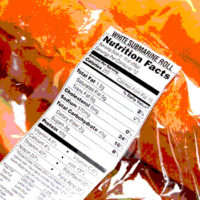Playing Whack-A-Mole with Your Food Safety

Every time you shop at your local grocery store, you’re rolling the dice with your health. We’re not just talking about obvious decisions like, “Should I buy a sweet potato or a box of freeze-dried mac and cheese?” We’re talking about products that consumers assume are safe: the jars of “natural” sauces displayed alluringly at your local Whole Foods; the “healthy” potato chips that are baked instead of fried, and the myriad of other products that profess to be natural, safe, or even organic. These are all foods that could contain an estimated 3,000 chemicals that the U.S. Food and Drug Administration (FDA) has never approved—all because Congress said it was okay over 50 years ago.
According to a 2013 report by the PEW Charitable Trusts, in 1958 Congress determined that food additives “generally recognized as safe” (GRAS) were fine to enter the market sans independent safety review. Back then, they were talking about “additives” like vinegar and salt; however, these days the same rules are used to sneak in untested chemicals. It’s no surprise that food manufacturers are happy with the status quo. The systems designed to protect consumers are outdated, complicated, and full of loopholes, meaning it’s easier than ever for untested chemicals to wind up in that bag of baked chips. The health dangers from individual chemicals range from a simple allergy to various cancers.
In addition to food, food packaging and a wide range of products—from household cleaners to paper receipts to cosmetics—can contain harmful chemicals. The danger is compounded when chemicals are synthesized, which they often are, and doesn’t disappear when the product is thrown away. A recent study found that one such chemical found in plastics was present in the bodies of 98 percentf of teens. Plastics and other materials containing potentially lethal compounds end up in landfills, where they can leak into groundwater and make their way into food crops. And yet, there hasn’t been a public outcry because consumer products on store shelves look safer than ever, and it’s assumed that regulatory bodies, including the FDA and the Environmental Protection Agency (EPA), are keeping the public safe.
The Problem with One-at-a-Time Tests
As many as 10 million new chemical compounds are synthesized every year. Yet, according to a January 2017 article in Science, government funding for research into how these chemicals affect humans or the environment falls woefully short. Moreover, a recent study conducted by researchers at Duke University in Durham, NC, found that the issue is getting short shrift from academics as well. The Duke study found that, over the past 25 years, less than 1 percent of papers published in the most highly cited ecological journals dealt with synthetic chemicals.
When it comes to chemicals' impact on human beings, the problem of lack of research is exacerbated by methods used for the few chemicals that are tested. Typically, each test done by an organization like the EPA or FDA monitors the impact of one chemical on one specific cell or tissue. That means it’s impossible to get a comprehensive view of how chemicals interact with the human body overall once ingested or absorbed.
Regulations slow down the testing process, too. In the U.S., for example, the EPA can’t force companies to test chemicals unless the EPA already has evidence that the chemical might cause harm. It’s like if new car models didn’t have to be safety-tested until they were already on the market and had already caused multiple accidents.
Even when the government does ban a chemical, the piecemeal approach to testing can make that ban ineffective. Remember bisphenol A (BPA)? In the early 2000s, it was everywhere—including 93 percent of urine samples in people 6 years old and up. In 2012, the FDA banned BPA from use in baby bottles and children’s cups, citing research that the chemical disrupts the human endocrine system and contributes to health problems from obesity to attention deficit hyperactivity disorder. However, most companies simply switched to nearly identical and equally damaging compounds like bisphenol S (BPS), which has been found to disrupt the endocrine system of zebrafish. If BPS is banned, it’s likely that it will be replaced by yet another chemical compound with a similar—and possibly more toxic—formula. With this one-time testing approach, regulatory bodies are in effect, playing whack-a-mole with each new chemical compound and simply can’t keep up.
The Need to Invest in Alternative Testing Methods
For years, companies relied on animal testing to accurately mimic how a product’s cocktail of chemicals would affect humans. However, animal testing was time-consuming and expensive, and once public opinion started turning against the practice, many companies abandoned its use. In the 1980s, the number of animals used in testing fell 90 percent.
In its place are a number of innovative testing techniques that are rising to prominence. Fish embryo testing, for example, is a holistic, nonanimal toxicity testing method already approved by the global body, the Organisation for Economic Co-operation and Development for use in determining a chemical’s potential impact on the environment. By testing toxicity against a whole organism, not just individual cells or tissues, this method offers a better approximation of how a given chemical would affect an actual human being—especially as certain fish species share 84 percent of disease-related genes with humans. Other promising techniques include testing chemicals on 3D-printed or lab-grown organs or using computer-based predictive toxicology models, both of which give a bigger-picture view of toxicity.
However, to take these solutions mainstream, companies need to invest in research & development and governments need to add regulatory muscle. Systemic changes like these always require significant consumer pressure—and as long as people continue to assume everything on their supermarket shelves is safe, there will be no urgency. The assumption that the government protects consumers from harmful chemicals has caused widespread complacency.
So What Can Be Done to Fix This?
First, consumers must become more informed about the chemicals that are in their food and other products. As more awareness (and questions) are raised publicly, companies will be under increasing pressure to both identify and discard harmful compounds used in production.
The other half of the equation lies with the government. If government regulatory agencies and private industry can work together, new, more efficient and more effective testing systems can be developed and implemented– better-protecting consumers now and in the future.
Jimmy Tao is CEO of Vitargent, a biotech company that performs toxicity testing on a number of products. He has spoken on the dangers of synthetic chemicals to audiences around the world. Tao received his BSc from the University of Manchester’s Institute of Science and Technology, and holds an MPhil in engineering from the University of Cambridge. He is a Clinton Global Initiative Commitment Scholar and an Advisor to the Our Hong Kong Foundation.
Looking for a reprint of this article?
From high-res PDFs to custom plaques, order your copy today!




